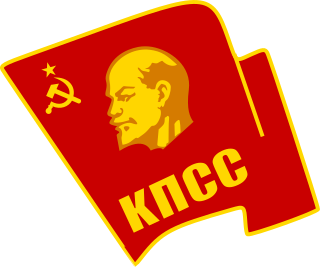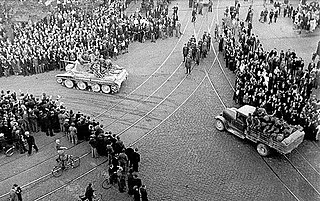
The occupation of the Baltic states involved the military occupation of the three Baltic states—Estonia, Latvia and Lithuania—by the Soviet Union under the auspices of the 1939 Molotov–Ribbentrop Pact in June 1940. They were then incorporated into the Soviet Union as constituent republics in August 1940, though most Western powers never recognised their incorporation. On 22 June 1941, Nazi Germany attacked the Soviet Union and within weeks occupied the Baltic territories. In July 1941, the Third Reich incorporated the Baltic territory into its Reichskommissariat Ostland. As a result of the Red Army's Baltic Offensive of 1944, the Soviet Union recaptured most of the Baltic states and trapped the remaining German forces in the Courland pocket until their formal surrender in May 1945. The Soviet "annexation occupation" or occupation sui generis of the Baltic states lasted until August 1991, when the three countries regained their independence.

The Forest Brothers were Estonian, Latvian, and Lithuanian partisans who waged a guerrilla war against Soviet rule during the Soviet invasion and occupation of the three Baltic states during, and after, World War II. Similar anti-Soviet Eastern European resistance groups fought against Soviet and communist rule in Bulgaria, Poland, Romania, and western Ukraine.

The Baltic Way or Baltic Chain was a peaceful political demonstration that occurred on 23 August 1989. Approximately two million people joined their hands to form a human chain spanning 675.5 kilometres (419.7 mi) across the three Baltic states – Estonia, Latvia, and Lithuania, which were considered at the time to be constituent republics of the Soviet Union.

Communist Party of Estonia was a political party in Estonia.
The People's Seimas was a puppet legislature organized in order to give legal sanction the occupation and annexation of Lithuania by the Soviet Union. After the Soviet ultimatum in June 1940, a new pro-Soviet government was formed, known as the People's Government. The new government dismissed the Fourth Seimas and announced elections to the People's Seimas. The elections were heavily rigged, and resulted in a chamber composed entirely of Communists and Communist sympathizers. The new parliament unanimously adopted a resolution proclaiming the Lithuanian Soviet Socialist Republic and petitioned for admission to the Soviet Union as a constituent republic. The Supreme Soviet of the USSR accepted the Lithuanian petition on August 3, 1940. The People's Seimas adopted a new constitution, a close copy of the 1936 Soviet Constitution, on August 25 and renamed itself to the Supreme Soviet of the Lithuanian SSR.

The Act of the Re-Establishment of the State of Lithuania or Act of March 11 was an independence declaration by the Lithuanian Soviet Socialist Republic adopted on March 11, 1990, signed by all members of the Supreme Council of the Republic of Lithuania led by Sąjūdis. The act emphasized restoration and legal continuity of the interwar-period Lithuania, which was occupied by the USSR and lost independence in June 1940. It was the first time that an occupied state declared independence from the dissolving Soviet Union.

State continuity of the Baltic states describes the continuity of the Baltic states as legal entities under international law while under Soviet rule and German occupation from 1940 to 1991. The prevailing opinion accepts the Baltic thesis of illegal occupation and the actions of the USSR are regarded as contrary to international law in general and to the bilateral treaties between the USSR and the Baltic states in particular.

The Soviet occupation of Latvia in 1940 refers, according to the European Court of Human Rights, the Government of Latvia, the United States Department of State, and the European Union, to the military occupation of the Republic of Latvia by the Soviet Union ostensibly under the provisions of the 1939 Molotov–Ribbentrop Pact with Nazi Germany.

Latvian national partisans were the Latvian national partisans who waged guerrilla warfare against Soviet rule during and after Second World War.

Relevant events began regarding the Baltic states and the Soviet Union when, following Bolshevist Russia's conflict with the Baltic states—Lithuania, Latvia and Estonia—several peace treaties were signed with Russia and its successor, the Soviet Union. In the late 1920s and early 1930s, the Soviet Union and all three Baltic States further signed non-aggression treaties. The Soviet Union also confirmed that it would adhere to the Kellogg–Briand Pact with regard to its neighbors, including Estonia and Latvia, and entered into a convention defining "aggression" that included all three Baltic countries.

The Soviet Union issued an ultimatum to Lithuania before midnight of June 14, 1940. The Soviets, using a formal pretext, demanded to allow an unspecified number of Soviet soldiers to enter the Lithuanian territory and to form a new pro-Soviet government. The ultimatum and subsequent incorporation of Lithuania into the Soviet Union stemmed from the division of Eastern Europe into the German and Russian spheres of influence in the Molotov–Ribbentrop Pact of August 1939. Lithuania, along with Latvia and Estonia, fell into the Russian sphere. According to the Soviet–Lithuanian Mutual Assistance Treaty of October 1939, Lithuania agreed to allow some 20,000 of Soviets troops to be stationed at several bases within Lithuania in exchange for a portion of the Vilnius Region. Further Soviet actions to establish its dominance in its sphere of influence were delayed by the Winter War with Finland and resumed in spring 1940 when Germany was making rapid advances in western Europe. Despite the threat to the independence, Lithuanian authorities did little to plan for contingencies and were unprepared for the ultimatum.
The Sovietization of the Baltic states refers to the sovietization of all spheres of life in Estonia, Latvia and Lithuania when they were under control of the Soviet Union. The first period deals with the occupation from June 1940 to July 1941 when the German occupation began. The second period covers 1944 when the Soviet forces pushed the German out, until 1991 when independence was declared.

The Estonian Soviet Socialist Republic, also known as Soviet Estonia or Estonia was an unrecognized republic of the Soviet Union, administered by a subordinate of the Soviet government. The ESSR was initially established on the territory of the Republic of Estonia on 21 July 1940, following the invasion of Soviet troops on 17 June 1940, and the installation of a puppet government backed by the Soviet Union, which declared Estonia a Soviet constituency. The Estonian SSR was subsequently incorporated into the Soviet state on 9 August 1940. The territory was occupied by Nazi Germany from 1941 to 1944 and administered as a part of Reichskommissariat Ostland.

The background of the occupation of the Baltic states covers the period before the first Soviet occupation on 14 June 1940, stretching from independence in 1918 to the Soviet ultimatums in 1939–1940. The Baltic states gained their independence during and after the Russian revolutions of 1917; Lenin's government allowed them to secede. They managed to sign non-aggression treaties in the 1920s and 1930s. Despite the treaties, the Baltic states were forcibly incorporated into the Soviet Union in 1940 in the aftermath of the German–Soviet pact of 1939.

This Baltic states were under Soviet rule from the end of World War II in 1945, from Sovietization onwards until independence was regained in 1991. The Baltic states were occupied and annexed, becoming the Soviet socialist republics of Estonia, Latvia and Lithuania. After their annexation by Nazi Germany, the USSR reoccupied the Baltic territories in 1944 and maintained control there until the Baltic states regained their independence nearly 50 years later in the aftermath of the Soviet coup of 1991.

The Soviet occupation of the Baltic states covers the period from the Soviet–Baltic mutual assistance pacts in 1939, to their invasion and annexation in 1940, to the mass deportations of 1941.

Parliamentary elections were held in Lithuania in 1940. They followed an ultimatum from the Soviet Union to allow Soviet troops to enter the country and operate freely. President Antanas Smetona left Lithuania on 15 June as the Soviet Army occupied the country and took control of the government. After a puppet government led by Justas Paleckis was installed, rigged elections were held.
Parliamentary elections were held in Estonia on 14 and 15 July 1940 alongside simultaneous elections in Latvia and Lithuania. The elections followed the Soviet occupation of the three countries, and were rigged. The Estonian Working People's Union, a Communist front group, was the only party allowed to run, and won all 80 seats with 92.8% of the vote. The newly elected People's Parliament declared the Estonian SSR on 21 July and requested admission to the Soviet Union the following day. The request was approved by the Soviet government on 6 August.












